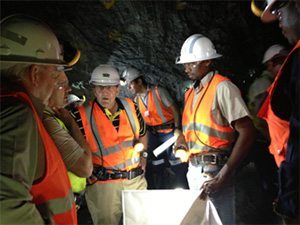
[miningmx.com] – RANDGOLD Resources CEO, Mark Bristow, has never been short an opinion, especially regarding the gold sector’s ability to blow itself up.
He thinks reluctance to close loss-making mines is another tap on the self-destruct button. “The industry is long past the point where it could have reinvented itself.
“The industry is now struggling with survival. It can’t get out of its own debt because it doesn’t have higher enough quality reserves. Banks too are too scared to pull the plug. When you look inside this kamono, it isn’t pleasant,’ he said in an interview with Miningmx.
If that sounds like self-pitying morbidity, it’s worth reflecting that Randgold is one of only a handful of gold mining firms that has its head clearly above water.
Debt-free, and generating profits from its west African mines, the company is keeping a close eye on merger and acquisition opportunities, even allowing for Bristow’s preference for organic growth.
That’s the model the company has pursued since inception, 20 years ago on August 7, 1995. Born in the teeth of the last gold price depression, when the metal was priced at $252/oz, Bristow’s Randgold almost went out of business.
Having come through near extinction just after inception is perhaps why Bristow is an arch conservative when it comes to planning around the gold price.
The declines in the gold price and gold producer share prices today are well documented. AngloGold Ashanti has lost 40% of its value in the last 12 months; and has surrendered two-thirds of its value in the last five.
Oddly enough, the gold price was trading at roughly $100 more per ounce in August 2010 than today’s level, but the trajectory was upwards. The gold price subsequently climbed to $1,420/oz by mid-December in 2010.
What’s changed is investors have become disillusioned with the sector’s inability to capitalise on those good times, providing precious little in returns and spending a wealth in development which accounts for the debt pressure today.
“The last drop in the gold price brought the cliff everyone is talking about into focus,’ said Bristow. “It’s almost like the industry wants to self-destruct. Companies are just mining gold now in order to cover their debt,’ he added.
Said Neal Froneman, CEO of Sibanye Gold: “Companies hold on to their assets for too long so it’s hard to consolidate the sector’. He also blames the lack of profound restructuring on that old chestnut, “executive ego’.
It seems that may lie at the root of Harmony Gold’s reticence to restructure, despite a number of overtures made to it over the years. In particular, Harmony chairman, Patrice Motsepe, views the 14% his company, African Rainbow Minerals (ARM), has in Harmony as part of his personal legacy. He is thought to be the single biggest reason the company hasn’t been sold.
AngloGold Ashanti is perhaps another company that is in danger of tarrying too long with its South African assets, an industry source said.
The group attempted to demerge them last year before shareholders opposed the rights issue that was to precede it, but analysts think there’s only so much that can be extracted from the cost-saving measures the company has since embarked upon. In the meantime, some temporary respite may be provided from the rand. According to Goldman Sachs, continued commodity price weakness will affect economic growth in South Africa, widen the country’s current account deficit and put further pressure on the currency, down 29% in the year-to-date. “As such a weaker ZAR would benefit Sibanye, Harmony and to a lesser extent, AngloGold,’ said Goldmans in a recent report.








